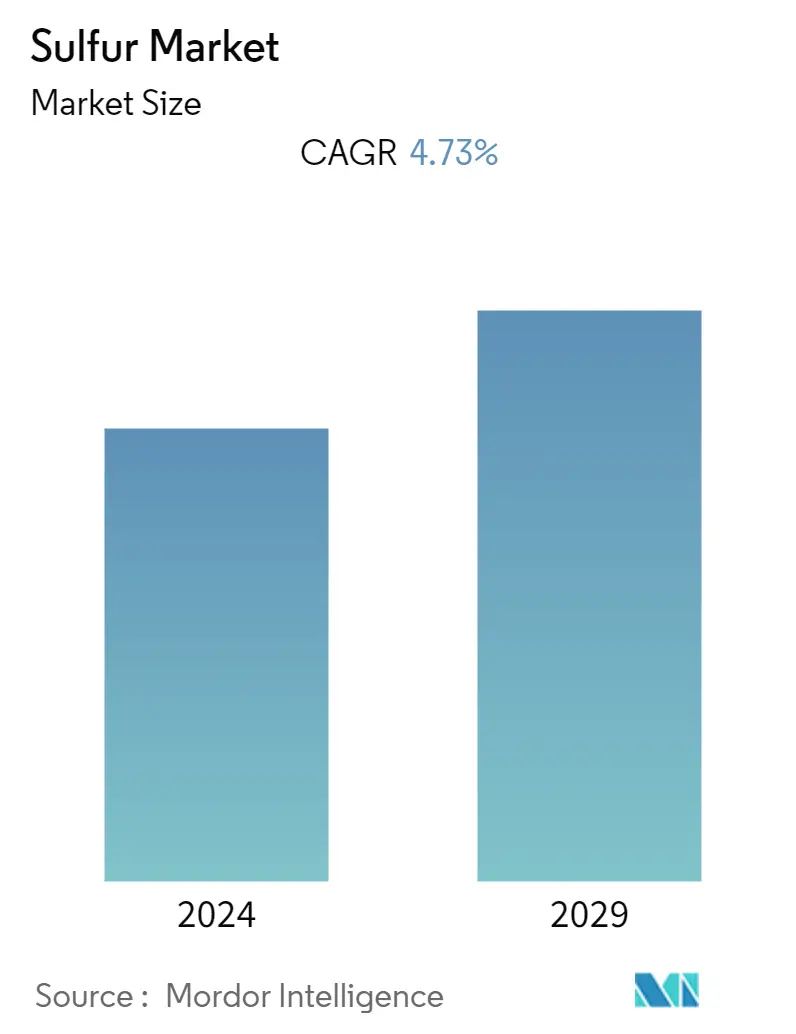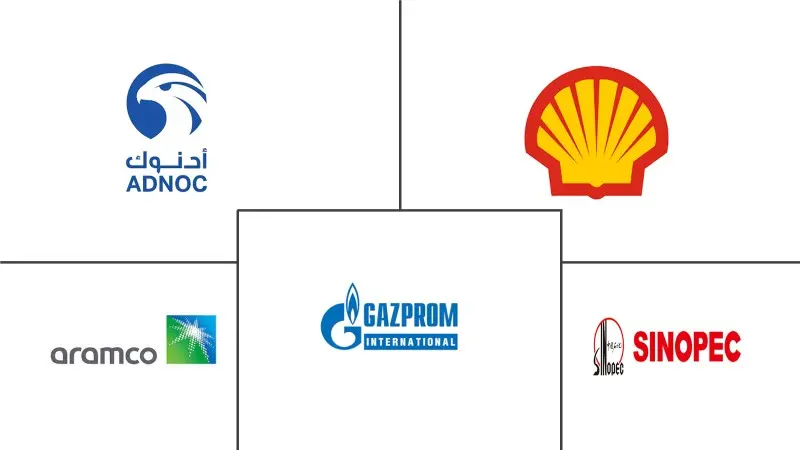Market Size of Sulfur Industry

| Study Period | 2019 - 2029 |
| Base Year For Estimation | 2023 |
| Forecast Data Period | 2024 - 2029 |
| CAGR | 4.73 % |
| Fastest Growing Market | Asia Pacific |
| Largest Market | Asia Pacific |
| Market Concentration | Low |
Major Players
*Disclaimer: Major Players sorted in no particular order |
Sulfur Market Analysis
The sulfur market is expected to grow from 77.30 million metric tons in 2023 to 97.41 million metric tons by 2028, at a CAGR of 4.73% during the forecast period.
Due to COVID-19, there has been a disruption in the supply of sulfur and a decline in the demand from multiple end-user industries, such as metal manufacturing and chemical processing. Moreover, the COVID-19 outbreak has completely disrupted the manufacturing and supply chains of fertilizers, which may hamper the market in the short term. However, the condition is expected to recover, which will restore the growth trajectory of the market studied during the latter half of the forecast period.
- Over the short term, major factors driving the growth of the sulfur market are the rising demand from the fertilizer manufacturing sector and the increasing usage of sulfur for the vulcanization of rubber.
- On the flip side, stringent environmental regulations regarding emissions are expected to hinder the market's growth.
- Usage of sulfur in cement polymer concrete is expected to act as an opportunity in the future.
- Asia-Pacific dominated the global market, with the largest consumption in terms of volume and value. The market is expected to witness substantial growth during the forecast period.
Sulfur Industry Segmentation
Sulfur is a multivalent non-metal, abundant, tasteless, and odorless. In its native form, sulfur is a yellow crystalline solid. In nature, it occurs as a pure element or as sulfide and sulfate minerals.
The sulfur market is segmented by form, technology (finishing process), end-user industry, and geography. By form, the market is segmented into solid and liquid. By technology, the market is segmented into granules, pastilles, and prilling. By end-user industry, the market is segmented into fertilizer, chemical processing, metal manufacturing, rubber processing, and other end-user industries. The report also covers the market size and forecasts for the sulfur market in 16 countries across major regions. For each segment, the market sizing and forecasts have been done on the basis of volume (million metric tons).
| Form | |
| Solid | |
| Liquid |
| Technology (Finishing Process) | |
| Granules | |
| Pastilles | |
| Prilling |
| End-User Industry | |
| Fertilizer | |
| Chemical Processing | |
| Metal Manufacturing | |
| Rubber Processing | |
| Other End-user Industries |
| Geography | ||||||||
| ||||||||
| ||||||||
| ||||||||
| ||||||||
|
Sulfur Market Size Summary
The sulfur market is poised for significant growth over the forecast period, driven primarily by its increasing demand in the fertilizer and rubber industries. The market experienced disruptions due to the COVID-19 pandemic, which affected supply chains and reduced demand from sectors like metal manufacturing and chemical processing. However, recovery is anticipated, restoring the market's growth trajectory. The fertilizer sector, in particular, is a major driver of sulfur demand, as it is a key component in producing fertilizers that enhance soil fertility and agricultural output. Additionally, sulfur's role in rubber vulcanization further contributes to its market expansion. Despite the positive outlook, the market faces challenges from stringent environmental regulations concerning emissions, which could impede growth. Nonetheless, opportunities exist in the use of sulfur in cement polymer concrete, potentially offering new avenues for market development.
The Asia-Pacific region dominates the global sulfur market, with substantial consumption driven by countries like China and India. China, a leading producer and importer of sulfur, utilizes a significant portion for sulfuric acid production, primarily for the fertilizer industry. The region's robust fertilizer production, supported by favorable government policies and initiatives, bolsters sulfur demand. India, a major rubber producer, also contributes to the region's sulfur consumption through its extensive rubber manufacturing industry. The market is characterized by fragmentation, with numerous global and regional players such as China Petrochemical Corporation, Gazprom International Limited, ADNOC Group, and Shell Plc. Recent developments, such as Technip Energies' contract for sulfur recovery equipment modernization and Valero Energy Corp's refinery expansion, highlight ongoing efforts to enhance sulfur recovery and comply with environmental standards, further shaping the market landscape.
Sulfur Market Size - Table of Contents
-
1. MARKET DYNAMICS
-
1.1 Drivers
-
1.1.1 Rising Demand From the Fertilizer Manufacturing Sector
-
1.1.2 Increasing Usage of Sulfur for Vulcanization of Rubber
-
1.1.3 Expansion of Petroleum Refining Plants
-
-
1.2 Restraints
-
1.2.1 Stringent Environmental Regulations Regarding Emissions
-
1.2.2 High Cost of Sulfur Mining Process
-
-
1.3 Industry Value Chain Analysis
-
1.4 Porter's Five Forces Analysis
-
1.4.1 Bargaining Power of Suppliers
-
1.4.2 Bargaining Power of Consumers
-
1.4.3 Threat of New Entrants
-
1.4.4 Threat of Substitute Products and Services
-
1.4.5 Degree of Competition
-
-
-
2. MARKET SEGMENTATION (Market Size in Volume)
-
2.1 Form
-
2.1.1 Solid
-
2.1.2 Liquid
-
-
2.2 Technology (Finishing Process)
-
2.2.1 Granules
-
2.2.2 Pastilles
-
2.2.3 Prilling
-
-
2.3 End-User Industry
-
2.3.1 Fertilizer
-
2.3.2 Chemical Processing
-
2.3.3 Metal Manufacturing
-
2.3.4 Rubber Processing
-
2.3.5 Other End-user Industries
-
-
2.4 Geography
-
2.4.1 Asia-Pacific
-
2.4.1.1 China
-
2.4.1.2 India
-
2.4.1.3 Japan
-
2.4.1.4 South Korea
-
2.4.1.5 ASEAN Countries
-
2.4.1.6 Rest of Asia-Pacific
-
-
2.4.2 North America
-
2.4.2.1 United States
-
2.4.2.2 Canada
-
2.4.2.3 Mexico
-
-
2.4.3 Europe
-
2.4.3.1 Germany
-
2.4.3.2 United Kingdom
-
2.4.3.3 Italy
-
2.4.3.4 France
-
2.4.3.5 Russia
-
2.4.3.6 Rest of Europe
-
-
2.4.4 South America
-
2.4.4.1 Brazil
-
2.4.4.2 Argentina
-
2.4.4.3 Rest of South America
-
-
2.4.5 Middle-East and Africa
-
2.4.5.1 Saudi Arabia
-
2.4.5.2 South Africa
-
2.4.5.3 Rest of Middle-East and Africa
-
-
-
Sulfur Market Size FAQs
What is the current Sulfur Market size?
The Sulfur Market is projected to register a CAGR of 4.73% during the forecast period (2025-2030)
Who are the key players in Sulfur Market?
China Petroleum & Chemical Corporation, Abu Dhabi National Oil Company, Gazprom International Limited, ADNOC Group and Shell Plc are the major companies operating in the Sulfur Market.

